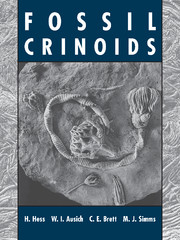Book contents
- Frontmatter
- Contents
- List of Contributors
- Acknowledgements
- Prelude
- Introduction
- GENERAL PART
- 1 Crinoid Form and Function
- 2 Systematics, Phylogeny and Evolutionary History
- 3 Fossil Occurrence
- 4 Taphonomy
- 5 Ecology and Ecological Interactions
- ASSEMBLAGES
- Appendix I Geological Time Table with Crinoid Assemblages
- Appendix II Glossary of Rocks
- Bibliography
- General Index
- Taxonomic Index
4 - Taphonomy
Published online by Cambridge University Press: 10 November 2010
- Frontmatter
- Contents
- List of Contributors
- Acknowledgements
- Prelude
- Introduction
- GENERAL PART
- 1 Crinoid Form and Function
- 2 Systematics, Phylogeny and Evolutionary History
- 3 Fossil Occurrence
- 4 Taphonomy
- 5 Ecology and Ecological Interactions
- ASSEMBLAGES
- Appendix I Geological Time Table with Crinoid Assemblages
- Appendix II Glossary of Rocks
- Bibliography
- General Index
- Taxonomic Index
Summary
PRESERVATION
Crinoids are rarely preserved as whole fossils. Instead, they commonly disarticulated after death and are preserved as partial crowns, cups, arm ossicles, stem fragments and individual columnals. Decay, disarticulation and preservation represent the field of study that we call taphonomy. Those who collect crinoids have probably always had an intuitive feeling for crinoid decay and disarticulation, but the scientific study of crinoid taphonomy did not begin until the 1960s. Cain (1968), Meyer (1971) and Liddell (1975b) were the first to document the fact that crinoids disarticulate very quickly on the sea floor after death. Within a few days after death, the muscles and ligaments of these animals decay, which leads to the disarticulation of the skeleton into isolated skeletal elements. For a complete crinoid to be preserved, it must be buried rapidly and deeply enough to prevent re-excavation by currents or disruption by scavengers or other burrowers (Lane 1971; Donovan 1991). Tempestites (storm deposits) and turbidites (submarine slides) represent common mechanisms for rapid burial, and many of the assemblages discussed in this book resulted from such types of deposition. Examples of studies of the sedimentology of crinoid localities include those of Franzén (1982), Brett and Eckert (1982), Schumacher and Ausich (1985), Aigner (1985), Parsons et al. (1988), D. L. Meyer et al. (1989), Brett and Seilacher (1991) and Schubert et al. (1992).
- Type
- Chapter
- Information
- Fossil Crinoids , pp. 50 - 54Publisher: Cambridge University PressPrint publication year: 1999
- 6
- Cited by



